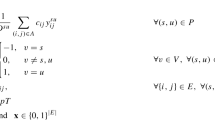Abstract
We apply the t-linearization technique to the maximum diversity problem (MDP) and compare its performance with other well-known linearizations. We lift the t-constraints based on the cardinality restriction, derive valid inequalities for MDP, and show their usefulness to solve the problem within the t-linearization framework. We propose and computationally evaluate a branch-and-bound algorithm on benchmark instances. The algorithm is compared with other exact approaches from the literature.
Similar content being viewed by others
References
Alidaee, B., Wang, H.: A note on heuristic approach based on UBQP formulation of the maximum diversity problem. J. Oper. Res. Soc. 68(1), 102–110 (2017)
Besanko, D., Perry, M.K., Spady, R.H.: The logit model of monopolistic competition: brand diversity. J. Ind. Econ. pp. 397–415 (1990)
Cevallos, A., Eisenbrand, F., Morell, S.: Diversity maximization in doubling metrics. In: Hsu, W.L., Lee, D.T., Liao, C.S. (eds) 29th International Symposium on Algorithms and Computation (ISAAC 2018), Leibniz International Proceedings in Informatics (LIPIcs), vol. 123, pp. 33:1–33:12. Schloss Dagstuhl–Leibniz-Zentrum fuer Informatik, Dagstuhl, Germany (2018)
Cevallos, A., Eisenbrand, F., Zenklusen, R.: Max-Sum Diversity Via Convex Programming. In: S. Fekete, A. Lubiw (eds.) 32nd International Symposium on Computational Geometry (SoCG 2016), Leibniz International Proceedings in Informatics (LIPIcs), vol. 51, pp. 26:1–26:14. Schloss Dagstuhl–Leibniz-Zentrum fuer Informatik, Dagstuhl, Germany (2016)
Duarte, A., Martí, R.: Tabu search and grasp for the maximum diversity problem. Eur. J. Oper. Res. 178(1), 71–84 (2007)
Eremeev, A.V., Kel’manov, A.V., Kovalyov, M.Y., Pyatkin, A.V.: Maximum diversity problem with squared euclidean distance. In: International Conference on Mathematical Optimization Theory and Operations Research, pp. 541–551. Springer (2019)
Erkut, E.: The discrete p-dispersion problem. Eur. J. Oper. Res. 46(1), 48–60 (1990)
Erkut, E., Neuman, S.: Comparison of four models for dispersing facilities. INFOR: Inf. Syst. Oper. Res. 29(2), 68–86 (1991)
Furini, F., Traversi, E.: Theoretical and computational study of several linearisation techniques for binary quadratic problems. Ann. Oper. Res. 279(1), 387–411 (2019)
Ghyczy, T.V.: Product diversity e proliferation as a new mode of competing in the motor car. Int. J. Veh. Des. 6(4–5), 423–425 (1985)
Glover, F.: Improved linear integer programming formulations of nonlinear integer problems. Manag. Sci. 22(4), 455–460 (1975)
Glover, F., Kuo, C.C., Dhir, K.S.: Heuristic algorithms for the maximum diversity problem. J. Inf. Optim. Sci. 19(1), 109–132 (1998)
Glover, F., Woolsey, E.: Converting the 0–1 polynomial programming problem to a 0–1 linear program. Oper. Res. 22(1), 180–182 (1974)
Gueye, S., Michelon, P.: A linearization framework for unconstrained quadratic (0–1) problems. Discret. Appl. Math. 157(6), 1255–1266 (2009)
Kuo, C.C., Glover, F., Dhir, K.S.: Analyzing and modeling the maximum diversity problem by zero-one programming. Decis. Sci. 24(6), 1171–1185 (1993)
Lai, X., Hao, J., Yue, D., Gao, H.: Diversification-driven memetic algorithm for the maximum diversity problem. In: 2018 5th IEEE International Conference on Cloud Computing and Intelligence Systems (CCIS), pp. 310–314. IEEE (2018)
Lin, G.: Solving the maximum diversity problem using simulated annealing based evolutionary algorithm. Int. J. Innov. Comput. Inf. Control 13(5), 1769–1776 (2017)
Macambira, E.M., Souza, C.C.D.: The edge-weighted clique problem: valid inequalities, facets and polyhedral computations. Eur. J. Oper. Res. 123(2), 346–371 (2000)
Martí, R., Gallego, M., Duarte, A.: A branch and bound algorithm for the maximum diversity problem. Eur. J. Oper. Res. 200(1), 36–44 (2010)
Martí, R., Gallego, M., Duarte, A., Pardo, E.G.: Heuristics and metaheuristics for the maximum diversity problem. J. Heuristics 19(4), 591–615 (2013)
Martí, R., Gallego, M., Duarte, A.: MDPLIB - Maximum Diversity Problem Library (2010). http://grafo.etsii.urjc.es/optsicom/mdp/
McConnell, S.: The new battle over immigration. Fortune 117(10), 89 (1988)
Pearce, D.: Economics e genetic diversity. Futures 19(6), 710–712 (1987)
Pisinger, D.: Upper bounds and exact algorithms for p-dispersion problems. Comput. Oper. Res. 33(5), 1380–1398 (2006)
Rodrigues, C., Quadri, D., Michelon, P., Gueye, S.: 0–1 quadratic knapsack problems: an exact approach based on a t-linearization. SIAM J. Optim. 22(4), 1449–1468 (2012)
San Segundo, P., Coniglio, S., Furini, F., Ljubić, I.: A new branch-and-bound algorithm for the maximum edge-weighted clique problem. Eur. J. Oper. Res. 278(1), 76–90 (2019)
Silva, G.C., Ochi, L.S., Martins, S.L.: Experimental comparison of greedy randomized adaptive search procedures for the maximum diversity problem. In: International Workshop on Experimental and Efficient Algorithms, pp. 498–512. Springer, Berlin (2004)
Swierenga, R.P.: Ethnicity in historical perspective. Social Science pp. 31–44 (1977)
Vera, K., Lopez-Pires, F., Baran, B., Sandoya, F.: Maximum diversity problem. a multi-objective approach. CLEI Eletron. J. 21(2), 1–16 (2018)
Zhou, Y., Hao, J.K., Duval, B.: Opposition-based memetic search for the maximum diversity problem. IEEE Trans. Evol. Comput. 21(5), 731–745 (2017)
Author information
Authors and Affiliations
Corresponding author
Additional information
Publisher's Note
Springer Nature remains neutral with regard to jurisdictional claims in published maps and institutional affiliations.
Rights and permissions
About this article
Cite this article
Soares, P., Campêlo, M. t-Linearization for the maximum diversity problem. Optim Lett 15, 2879–2895 (2021). https://doi.org/10.1007/s11590-021-01719-y
Received:
Accepted:
Published:
Issue Date:
DOI: https://doi.org/10.1007/s11590-021-01719-y




